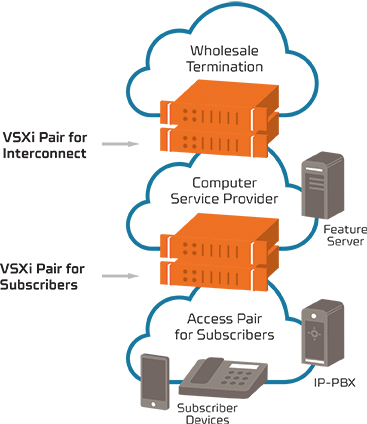The VSXi session controller is a high-performance software-based SBC that provides critical functions for communications service providers, including security and DDoS protection, network address translation, protocol interworking and traffic management. In the graphic, two pairs of VSXi session controllers are deployed in a high-availability (HA) configuration, serving network-facing and subscriber-facing requirements. Deployed for network interconnection, the VSXi selects optimal routes for voice communications traffic and assures effective interworking with outside networks. For subscriber-facing traffic management, the session controller provides packet-header manipulation and digit mapping for automatic number identification (ANI) and dialed number identification services (DNIS) manipulation.

Key functionality provided by the VSXi includes the following:
- Network topology protection and asset hiding
- Prevention of distributed denial of service (DDoS) attacks through sophisticated network security mechanisms
- Advanced management of signaling and media throughput under all load conditions
- Firewall and network address translation (NAT) traversal, near and far end
- Secure Real-Time Transport Protocol (SRTP) support
- TLS – signaling encryption
- Local number portability (LNP) dipping and complete control of inbound/outbound RN handling
- Session-routing based on ANI and DNIS jurisdictional control
- Manages 90M routes in 1,000 different route tables
- Generate call detail records (CDR) with retrieval via RADIUS, FTP, RSync and SCP
- Performance monitoring with metrics updated in real time
- Protocol interworking for SIP and H.323
- Media transcoding, including fixed and wireless audio codecs and video codecs
The VSXi is the highest-performing session control platform in the market today. The software-based VSXi SBC runs on a compact, one-rack unit (1RU), Linux-based commercial off-the-shelf server. A single VSXi node scales to over 5,000 cps and 500,000 sessions. VSXi clusters of up to 16 nodes provide the necessary scale for any VoIP network deployment– all with greater than 99.999 percent availability. Each VXSi node INX can control up to 32 MST3, with each MST3 handling 14,000 G711 SRTP sessions, and 50,000 non-SRTP sessions.
The carrier-grade VSXi can be positioned at the core or edge of the network to manage VoIP traffic between SIP proxies, SIP UAs, H.323 gateways, IP-PBXs and H.323 gatekeepers.
Sansay’s routing tables and LCR capabilities optimize bandwidth costs in a variety of VoIP peering applications, allowing carriers to interconnect without requiring traditional class 4 TDM switches in the call path. Replacing the relevant Class 4 functions—call routing, CDR generation, security and network privacy—the VSXi also acts as the “billing switch” between carriers at a fraction of the cost. VOIP providers can move the peering function off softswitches and gatekeepers to make networks more secure and reliable, and a wide range of services more profitable.
In access applications, Sansay’s VSXi VoIP session controller works in conjunction with Class 5 switches, feature servers and gateways. The VSXi also enables a broad range of differentiated services while ensuring interoperability and secure firewall/NAT/call admission control. The VSXi also acts as a registrar. Enforcing the borders, Sansay’s VSXi session controllers protect network topography while preventing DoS attacks to keep service provider infrastructures secure within the internal VPN. Our SBCs support SLAs and eliminate the voice-quality degradation and delays caused by multiple compression/decompressions when TDM equipment is used to switch VOIP calls between carriers. Sansay also interconnects to leading ENUM databases to enable providers to minimize costs by completing calls using all-VoIP networks whenever possible.
Architected for profitable growth for niche applications to the world’s largest service providers, Sansay helps reduce not only the costs of building and managing networks, but of operating services themselves. Performing multiple functions, the VSXi minimizes the cost and complexity associated with maintaining extra gateways, softswitches and port licenses.
Deployment Models: Sansay utilizes a common software code base for VoIP security, performance and robustness whether deployed in public, private, and hybrid clouds as an appliance, software or in the cloud. The vmVSXi virtualized session border controller can be deployed on KVM, VMware, AWS, Google, and IBM instances.